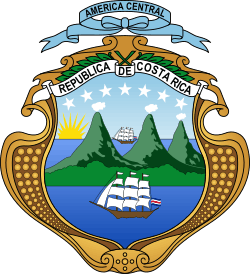Public finances in Costa Rica
The pattern of public expenditure and revenue in Costa Rica is typical of a middle income country. According to the CIA World Factbook, in 2012, central government revenue was US$6.949 billion, while expenditure was $8.937 billion.[1] In recent years, expenditure has grown faster than income, producing deficits.
Revenue
The major sources of revenue are income taxes, indirect taxes, social security contributions and customs duties. According to figures prepared by the Costa Rican government for the International Monetary Fund, the basic breakdown as a percentage of GDP is as in the table below.[2]
| Item (% GDP) | 2007 | 2008 | 2009 |
|---|---|---|---|
| Tax revenue | 15.2 | 15.6 | 13.9 |
| Direct taxes | 4.6 | 5.1 | 4.7 |
| Sales tax | 5.9 | 6.0 | 5.0 |
| Excise, customs, and others | 4.8 | 4.6 | 4.3 |
| Nontax revenue | 0.3 | 0.2 | 0.3 |
| Contributions to social security | 6.3 | 6.7 | 7.1 |
| Operating balance of public enterprises | 1.0 | 0.5 | 0.6 |
| Total Revenues | 22.8 | 23.1 | 21.9 |
There is no VAT in Costa Rica, but there is a generally applied sales tax of 13% that, combined with excise taxes on specific consumption goods raises around half of government revenue. Income tax rates rise with reported income, beginning at 10% for annual income over Costa Rican colón 41,112,000. As of 2010, the top rate of 30% applies to people earning in excess of Costa Rican colón 82,698,000. Nominally, employers are responsible for the bulk of social security contributions.
Expenditure
The largest components of expenditure are education (21.3% of government expenditure in 2007/08), social protection (21.1%) and healthcare (19%). There is no expenditure on defence.[3] In cash terms, expenditure has risen steeply: healthcare expenditure rose by a factor of 4.5 between 1999 and 2008, while social protection rose by a factor of 4 over the same period.[3]
Borrowing and debt
According to the IMF[2] (the source for the table below), in most years recently Costa Rica has run fiscal deficits, but in 2007 and 2008 small surpluses were reported. Combined with some growth of the economy this has produced a decline in the debt-to-GDP ratio. The year 2009 saw a significant decline in the state of public finances and the IMF is forecasting deficits from 2010 to 2013.
| Item (% GDP) | 2007 | 2008 | 2009 | 2010 (est.) |
|---|---|---|---|---|
| Overall balance (% GDP) | 1.2 | 0.1 | -4.0 | -4.5 |
| Combined Public Sector Debt (%GDP) | 43.2 | 35.7 | 37.9 | 37.9 |
Externally held public sector debt fell from 7.7% of GDP in 2007 to 5.5% in 2008.[2]
References
- "Costa Rica". The World Factbook. CIA. Retrieved 22 February 2013.
- "Costa Rica: Third and Final Review Under the Stand-By Arrangement—Staff Report; Press Release on the Executive Board Discussion; and Statement by the Executive Director for Costa Rica". IMF Country Report No. 10/162. International Monetary Fund. June 2010.
- "Table W6. Outlays by Function: General and Central Government". Government Finance Statistics 2008. International Monetary Fund Government Statistics. p. 30.
External links
- Costa Rica Ministry of Finance (in Spanish)
